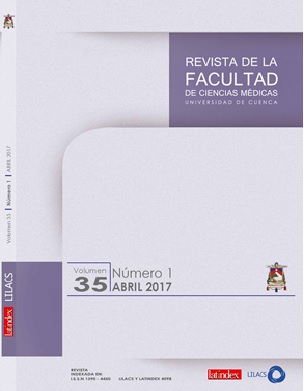FRECUENCIA DE ESCHERICHIA COLI BETALACTAMASA DE ESPECTRO EXTENDIDO (BLEE), EN PACIENTES CON INFECCION DE VÍAS URINARIAS. HOSPITAL JOSÉ CARRASCO ARTEAGA.
Abstract
RESUMEN
OBJETIVOS: Determinar la Frecuencia de Eschericia coli Beta Lactamasa de Espectro Extendido en Infecciones de Vías Urinarias, en el hospital José Carrasco Arteaga 2012-2013.
MÉTODOLOGÍA: Observacional de tipo descriptivo prospectivo transversal. La población estudiada estuvo conformada por 605 muestras de urocultivos de pacientes de las áreas de: consulta externa, emergencia, hospitalización y cuidados intensivos. Se efectuó la prueba del método de confirmación apropiado, basado en la inhibición de la enzima β-Lactamasas de confirmación productora de β-Lactamasa según las normas Standard Institute Clinical Laboratory. Se realizó el análisis estadístico descriptivo para comprensión e interpretación de datos.
RESULTADOS: Se cultivó 605 muestras, se reportó E. coli en 455 muestras de las cuales 82 correspondieron a la cepa productora de β-Lactamasas de Expectro Extendido un 18%. Según las variables consideradas, de acuerdo al sexo las mujeres representaron el mayor porcentaje con un 87,8%, el grupo etario con mayor reporte fue el de 51-60 años con el 20,7%, seguido del grupo de 61-70 con el 17,1%, según la procedencia, el área urbana representó 69,5%, de acuerdo a los servicios en consulta externa se reportó 37,8% y en emergencia el 34,1%.
CONCLUSIÓN: en el hospital José Carrasco Arteaga en el periodo septiembre 2012-enero 2013 se reportó una prevalencia del 18% de E. coli productora de β-Lacatamasa en muestras de urocultivo de pacientes de los servicios de consulta externa, emergencia, hospitalización y cuidados intensivos. Las mujeres fueron las más afectadas, según procedencia el mayor porcentaje fue del área urbana, el grupo de adultos representó el mayor porcentaje y la consulta externa fue el servicio con mayor frecuencia. (Impacto de los resultados
PALABRAS CLAVE: Infección Vías Urinarias, E. coli, Betalactamasa de Espectro Extendido (BLEE), Cultivo
ABSTRACT
OBJECTIVES: To determine the frequency of Escherichia coli extended spectrum lactamasa in urinary tract infections, at José Carrasco Arteaga Hospital, 2012-2013.
METHODOLOGY: It is an observational descriptive cross-sectional study. The population consisted of 605 samples of urine cultures of patients from the areas of: external consultation, emergency, hospitalization and intensive care. The appropriate confirmatory method was tested, it was based on the inhibition of β-Lactamasa-producing confirmation enzyme according to the Standard Institute Clinical Laboratory. A descriptive statistical analysis was performed for data comprehension and interpretation.
RESULTS: A total of 605 samples were cultured, E. coli was reported in 455 samples, and only 82 corresponded to the extended Expectrum β-lactamase producing strain with 18%. According to the variables considered, regarding sex, women represented the highest percentage with 87.8%, the highest age group was 51-60 years with 20.7%, followed by the group of 61-70 with 17.1%, depending on the source, the urban area accounted for 69.5%, according to the services in external consultation 37.8% were reported, and 34.1% were emergency ones.
CONCLUSION: A prevalence of 18% of E. coli producing β-Lactamasa was reported at the José Carrasco Arteaga Hospital in the period September 2012-January 2013 in urine samples of patients from external consultation, emergency, hospitalization and Intensive care services. The women were the most affected, according to provenance, the highest percentage was of the urban area, the group of adults represented the highest percentage and the external consultation service was the most frequent. (Impact of results).
KEYWORDS: Urinary Tract Infection, E. coli, Extended Spectrum Betalactamasa (ESBL), Cultivation
Downloads
Downloads
Published
Issue
Section
License
Copyright © Autors.

You are free to:
 |
Share — copy and redistribute the material in any medium or format |
 |
Adapt — remix, transform, and build upon the material for any purpose, even commercially. |
Under the following conditions:
 |
Attribution — You must give appropriate credit, provide a link to the licence, and indicate if changes were made. You may do so in any reasonable manner, but not in any way that suggests the licenser endorses you or your use. |
| NonCommercial — You may not use the material for commercial purposes. | |
| ShareAlike — If you remix, transform, or build upon the material, you must distribute your contributions under the same license as the original. |
| No additional restrictions — You may not apply legal terms or technological measures that legally restrict others from doing anything the licence permits. |






